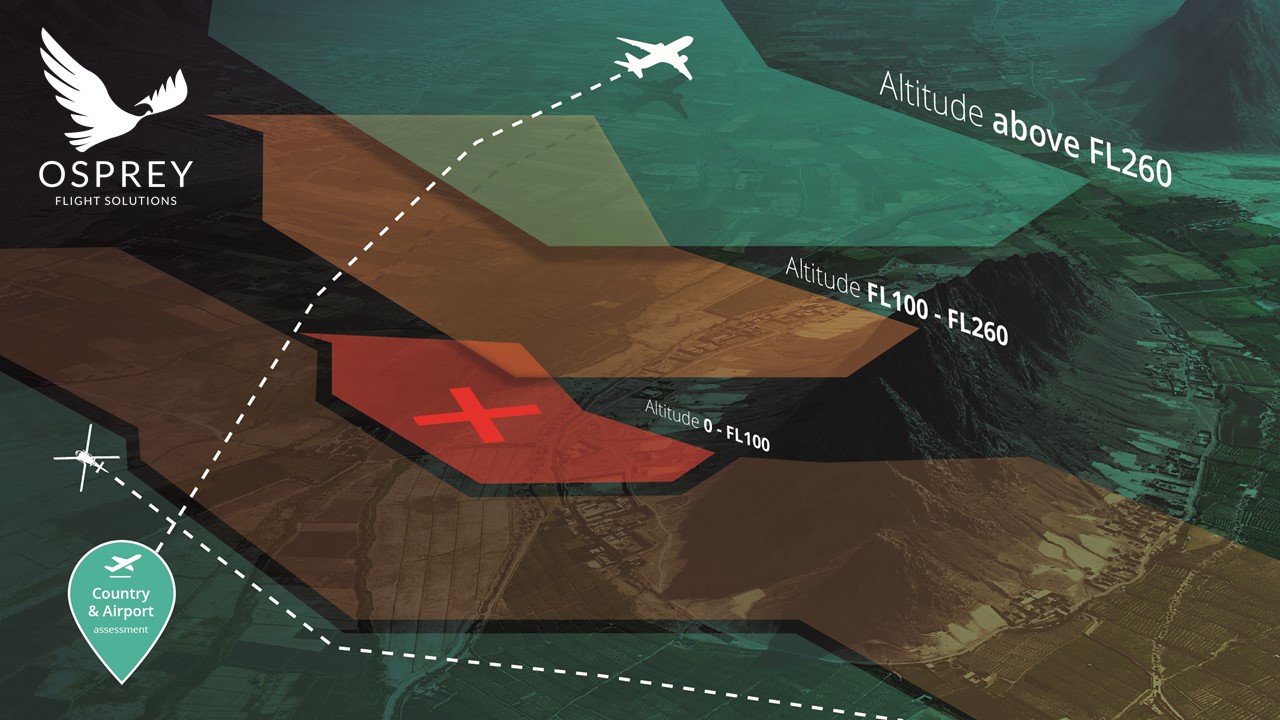Aircraft operators, from the largest scheduled carriers through cargo aircraft, air ambulances and down to single business jet owners, need a modern, effective risk management tool covering security, safety and regulatory issues that also ensures maximum efficiency and profitability for an operation.
Data-led risk management provides precisely that capability: substantive, tailored analysis, delivered in an objective, exceptionally fast and near real-time manner. Modern computer capabilities, enhanced through advanced data gathering and AI techniques such as machine learning, provide the operator at the simple click of a button with a bespoke, detailed risk assessment, fully quantified and qualified via substantive supporting data.
This is the unique tool offered by Osprey Flight Solutions. Every flight covered in depth, yet imposing a negligible burden on the operator, resulting in improved efficiency and accelerated assessments.

Data-led risk management in detail
Data-led risk management is an exciting, emerging field in both academic study and operational support. Modern computing techniques and capabilities such as Artificial Intelligence, advanced web-scraping and data-gathering, new visualisation techniques and standardised cross-platform integration enable huge amounts of data to be collated, structured, analysed and visualised far more quickly than a purely human system could.
Concepts such as Predictive Maintenance Analysis – the gathering of large amounts of structured data from hundreds of sensors to detect tiny pre-indicators of failure for large machinery – are the kernel for the development of more proactive risk management capabilities that, as a start, could forecast the probability of incidents and events that have an impact on aviation operations.

Data-led risk management has the potential to break down all the barriers that operators face in conducting a proper and effective risk assessment.
Traditionally, risk management has relied on the expertise of analysts and consultants to understand the environment and make connections between incidents and events based on limited information. This was the only option: there was simply not enough data to quantify these connections.
Even if there had been, computers were not powerful enough to deal with the amount of data needed. That has changed. There is so much open-source data available that there is no longer a need to fill the gaps with assumptions. Computers can gather, filter and analyse millions – even billions – of data points a second.
This is the fundamental basis behind data-led risk assessment and management: using as much data as possible to develop an analysis of a particular location or environment based on the quantified likelihood and impact. This ensures that the analysis is objective, consistent, accurate and extremely fast, in near real-time. With these capabilities, it is no longer necessary to accept risk management support provided solely by a human, based on assumptions that have been biased by their own environment and the limitations of tens of information sources that is the maximum they can access in a reasonable time frame. Nor should it be necessary to wait a day, two days, or even a week when an operator is conducting 10, 100 or 1000 flights every single day. And surely it is no longer acceptable for there to be no operationally and financially practicable mechanism to assess every one of these flights. Enabled by data-led risk assessment process, this capability is now available for operators.
Data-led risk management has the potential to break down all the barriers that operators face in conducting a proper and effective risk assessment. No longer is there any need for it to be a complicated, burdensome, time-consuming, expensive process. The ability to click a button and instantaneously receive a full, quantified and qualified risk assessment, with all the supporting data, bespoke to any flight operation and fed through an operator’s existing software tools, is already here: it is the fundamental requirement of the Osprey Flight Solutions system.

Whilst the methodology behind the process is complex and comprehensive and the analysis capability behind the assessments amongst the highest quality across the industry, the burden on an operator is negligible and actually improves efficiency. This means that a systematic, effective risk assessment of every single flight is available to every operator, from the smallest, single aircraft corporate flight department, through non-scheduled air ambulance or cargo operations, through to the largest, scheduled passenger carriers.
Risk management is often considered distinct from operations. Forward-looking operators see the value of proper risk management, but even then the security department is not integrated with operations as well as it could be. Proper, effective risk management should: keep everyone as safe and secure as possible, whilst also reflecting a proper understanding of the commercial imperative of operators; be integrated across all risk types – security, safety, regulatory; and should therefore be an operational tool to maximise the safety, efficiency and profitability of an operation. Data-led techniques enable this, as they allow integration with existing software tools such as flight planning solutions to visualise information and support operational decision-making. This should also enable operators to maximise the profitability of their operations whilst maintaining the highest standards of safety and security. Data-led risk management techniques allow us to do this by being far more accurate about the risks operators face, therefore enabling more efficient yet still effective mitigating measures.
Poor risk analysis is worse than no analysis. Subjective and inconsistent assumptions and conclusions can lead at best to the need for a significant margin of error to be taken into account, adding cost and burden to operators, at worst to the wrong decisions being taken, putting people’s lives in danger. Data-led risk management techniques are inherently objective and, using modern computing techniques, far more data can be gathered and analysed than a purely human service could ever achieve, making it more accurate, consistent, faster and comprehensive.
The aviation industry has different requirements and operates in a different environment than any other industry. Risk management support needs first to understand those requirements and secondly to deliver them through mechanisms that are aligned with the operational tempo and environment. There is no point is seeking support from a business travel analyst, who would not understand the environment or the requirements. Aviation expertise is essential, and so is the right tool.







